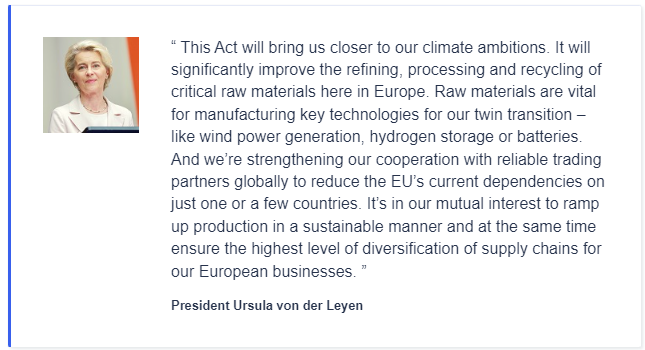The Critical Raw Materials Act will equip the EU with the tools to ensure the EU’s access to a secure and sustainable supply of critical raw materials, mainly through:
Setting clear priorities for action: In addition to an updated list of critical raw materials, the Act identifies a list of strategic raw materials, which are crucial to technologies important to Europe’s green and digital ambitions and for defence and space applications, while being subject to potential supply risks in the future. The Regulation embeds both the critical and strategic raw materials lists in EU law. The Regulation sets clear benchmarks for domestic capacities along the strategic raw material supply chain and to diversify EU supply by 2030:
- At least 10% of the EU’s annual consumption for extraction,
- At least 40% of the EU’s annual consumption for processing,
- At least 15% of the EU’s annual consumption for recycling,
- Not more than 65% of the Union’s annual consumption of each strategic raw material at any relevant stage of processing from a single third country.
Creating secure and resilient EU critical raw materials supply chains: The Act will reduce the administrative burden and simplify permitting procedures for critical raw materials projects in the EU. In addition, selected Strategic Projects will benefit from support for access to finance and shorter permitting timeframes (24 months for extraction permits and 12 months for processing and recycling permits). Member States will also have to develop national programmes for exploring geological resources.
Ensuring that the EU can mitigate supply risks: To ensure resilience of the supply chains, the Act provides for the monitoring of critical raw materials supply chains, and the coordination of strategic raw materials stocks among Member States. Certain large companies will have to perform an audit of their strategic raw materials supply chains, comprising a company-level stress test.
Investing in research, innovation and skills: The Commission will strengthen the uptake and deployment of breakthrough technologies in critical raw materials. Furthermore, the establishment of a large-scale skills partnership on critical raw materials and of a Raw Materials Academy will promote skills relevant to the workforce in critical raw materials supply chains. Externally, the Global Gateway will be used as a vehicle to assist partner countries in developing their own extraction and processing capacities, including skills development.
Protecting the environment by improving circularity and sustainability of critical raw materials: Improved security and affordability of critical raw materials supplies must go hand in hand with increased efforts to mitigate any adverse impacts, both within the EU and in third countries with respect to labour rights, human rights and environmental protection. Efforts to improve sustainable development of critical raw materials value chains will also help promoting economic development in third countries and also sustainability governance, human rights, conflict-resolution and regional stability.
Member States will need to adopt and implement national measures to improve the collection of critical raw materials rich waste and ensure its recycling into secondary critical raw materials. Member States and private operators will have to investigate the potential for recovery of critical raw materials from extractive waste in current mining activities but also from historical mining waste sites. Products containing permanent magnets will need to meet circularity requirements and provide information on the recyclability and recycled content.

Recent Comments